
Membrane bioreactor
Encyclopedia
Membrane bioreactor is the combination of a membrane process
like microfiltration
or ultrafiltration
with a suspended growth bioreactor
, and is now widely used for municipal and industrial wastewater
treatment with plant sizes up to 80,000 population equivalent (i.e. 48 MLD).
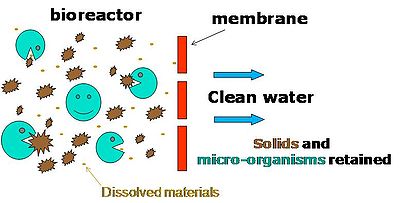 When used with domestic wastewater, MBR processes could produce effluent of high quality enough to be discharged to coastal, surface or brackish waterways or to be reclaimed for urban irrigation. Other advantages of MBRs over conventional processes include small footprint, easy retrofit and upgrade of old wastewater treatment plants.
When used with domestic wastewater, MBR processes could produce effluent of high quality enough to be discharged to coastal, surface or brackish waterways or to be reclaimed for urban irrigation. Other advantages of MBRs over conventional processes include small footprint, easy retrofit and upgrade of old wastewater treatment plants.
It is possible to operate MBR processes at higher mixed liquor suspended solids (MLSS) concentrations compared to conventional settlement separation systems, thus reducing the reactor volume to achieve the same loading rate.
Two MBR configurations exist: internal/submerged, where the membranes are immersed in and integral to the biological reactor; and external/sidestream, where membranes are a separate unit process requiring an intermediate pumping step.
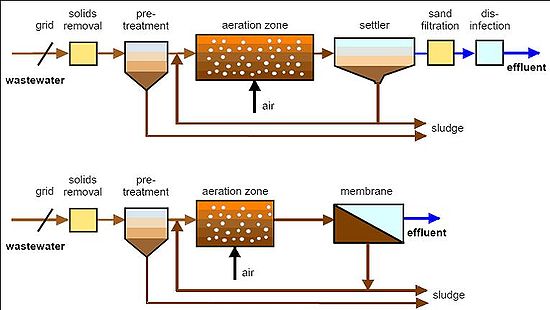 Recent technical innovation and significant membrane cost reduction have pushed MBRs to become an established process option to treat wastewaters. As a result, the MBR process has now become an attractive option for the treatment and reuse of industrial and municipal wastewaters, as evidenced by their constantly rising numbers and capacity. The current MBR market has been estimated to value around US$216 million in 2006 and to rise to US$363 million by 2010.
Recent technical innovation and significant membrane cost reduction have pushed MBRs to become an established process option to treat wastewaters. As a result, the MBR process has now become an attractive option for the treatment and reuse of industrial and municipal wastewaters, as evidenced by their constantly rising numbers and capacity. The current MBR market has been estimated to value around US$216 million in 2006 and to rise to US$363 million by 2010.
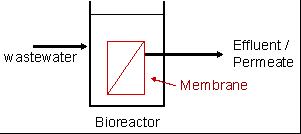
(UF) and microfiltration
(MF) membranes were available. The original process was introduced by Dorr-Olivier Inc. and combined the use of an activated sludge
bioreactor with a crossflow membrane filtration loop. The flat sheet membranes used in this process were polymeric and featured pore sizes ranging from 0.003 to 0.01 μm. Although the idea of replacing the settling tank of the conventional activated sludge
process was attractive, it was difficult to justify the use of such a process because of the high cost of membranes, low economic value of the product (tertiary effluent) and the potential rapid loss of performance due to membrane fouling. As a result, the focus was on the attainment of high fluxes, and it was therefore necessary to pump the mixed liquor suspended solids (MLSS) at high crossflow velocity at significant energy penalty (of the order 10 kWh/m3 product) to reduce fouling. Due to the poor economics of the first generation MBRs, they only found applications in niche areas with special needs like isolated trailer parks or ski resorts for example.
The breakthrough for the MBR came in 1989 with the idea of Yamamoto and co-workers to submerge the membranes in the bioreactor. Until then, MBRs were designed with the separation device located external to the reactor (sidestream MBR) and relied on high transmembrane pressure (TMP) to maintain filtration. With the membrane directly immersed into the bioreactor, submerged MBR systems are usually preferred to sidestream configuration, especially for domestic wastewater treatment. The submerged configuration relies on coarse bubble aeration to produce mixing and limit fouling. The energy demand of the submerged system can be up to 2 orders of magnitude lower than that of the sidestream systems and submerged systems operate at a lower flux, demanding more membrane area. In submerged configurations, aeration is considered as one of the major parameter on process performances both hydraulic and biological. Aeration maintains solids in suspension, scours the membrane surface and provides oxygen to the biomass, leading to a better biodegradability and cell synthesis.
The other key steps in the recent MBR development were the acceptance of modest fluxes (25% or less of those in the first generation), and the idea to use two-phase bubbly flow to control fouling. The lower operating cost obtained with the submerged configuration along with the steady decrease in the membrane cost encouraged an exponential increase in MBR plant installations from the mid 90s. Since then, further improvements in the MBR design and operation have been introduced and incorporated into larger plants. While early MBRs were operated at solid retention times (SRT) as high as 100 days with mixed liquor suspended solids up to 30 g/L, the recent trend is to apply lower solid retention times (around 10–20 days), resulting in more manageable mixed liquor suspended solids (MLSS) levels (10-15 g/L). Thanks to these new operating conditions, the oxygen transfer and the pumping cost in the MBR have tended to decrease and overall maintenance has been simplified. There is now a range of MBR systems commercially available, most of which use submerged membranes although some external modules are available; these external systems also use two-phase flow for fouling control. Typical hydraulic retention times (HRT) range between 3 and 10 hours. In terms of membrane configurations, mainly hollow fibre and flat sheet membranes are applied for MBR applications.
Despite the more favourable energy usage of submerged membranes, there continued to be a market for the side stream configuration, particularly in industrial applications. For ease of maintenance the side stream configuration can be installed at low level in a plant building. Membrane replacement can be undertaken without specialised lifting equipment. As a result research continued with the side stream configuration, during which time it was found that full scale plants could be operated with higher fluxes. This has culminated in recent years with the development of low energy systems which incorporate more sophisticated control of the operating parameters coupled with periodic back washes, which enable sustainable operation at energy usage as low as 0.3 kWh/m3 product.
components and the membrane. This major drawback and process limitation has been under investigation since the early MBRs, and remains one of the most challenging issues facing further MBR development,.
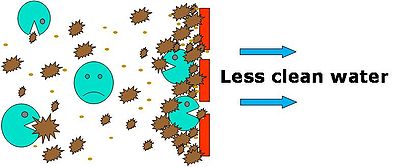 In recent reviews covering membrane applications to bioreactors, it has been shown that, as with other membrane separation processes, membrane fouling is the most serious problem affecting system performance. Fouling leads to a significant increase in hydraulic resistance, manifested as permeate flux decline or transmembrane pressure (TMP) increase when the process is operated under constant-TMP or constant-flux conditions respectively. In systems where flux is maintained by increasing TMP, the energy required to achieve filtration increases. Alternatively frequent membrane cleaning is therefore required, increasing significantly the operating costs as a result of cleaning agents and production downtime. More frequent membrane replacement is also expected.
In recent reviews covering membrane applications to bioreactors, it has been shown that, as with other membrane separation processes, membrane fouling is the most serious problem affecting system performance. Fouling leads to a significant increase in hydraulic resistance, manifested as permeate flux decline or transmembrane pressure (TMP) increase when the process is operated under constant-TMP or constant-flux conditions respectively. In systems where flux is maintained by increasing TMP, the energy required to achieve filtration increases. Alternatively frequent membrane cleaning is therefore required, increasing significantly the operating costs as a result of cleaning agents and production downtime. More frequent membrane replacement is also expected.
Membrane fouling results from interaction between the membrane material and the components of the activated sludge liquor, which include biological flocs formed by a large range of living or dead microorganisms along with soluble and colloidal compounds. The suspended biomass has no fixed composition and varies both with feed water composition and MBR operating conditions employed. Thus though many investigations of membrane fouling have been published, the diverse range of operating conditions and feedwater matrices employed, the different analytical methods used and the limited information reported in most studies on the suspended biomass composition, has made it difficult to establish any generic behaviour pertaining to membrane fouling in MBRs specifically.
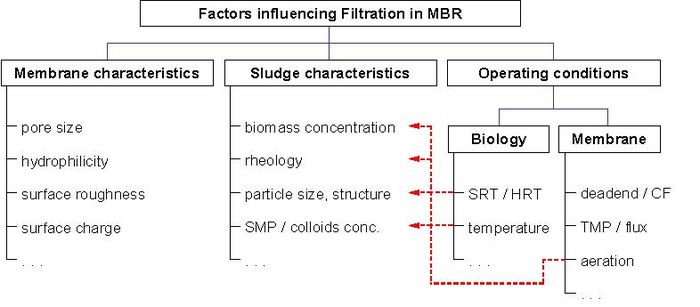 The air-induced cross flow obtained in submerged MBR can efficiently remove or at least reduce the fouling layer on the membrane surface. A recent review reports the latest findings on applications of aeration in submerged membrane configuration and describes the enhancement of performances offered by gas bubbling. As an optimal air flow-rate has been identified behind which further increases in aeration have no effect on fouling removal, the choice of aeration rate is a key parameter in MBR design.
The air-induced cross flow obtained in submerged MBR can efficiently remove or at least reduce the fouling layer on the membrane surface. A recent review reports the latest findings on applications of aeration in submerged membrane configuration and describes the enhancement of performances offered by gas bubbling. As an optimal air flow-rate has been identified behind which further increases in aeration have no effect on fouling removal, the choice of aeration rate is a key parameter in MBR design.
Many other anti-fouling strategies can be applied to MBR applications. They comprise, for example:
In addition, different types/intensities of chemical cleaning may also be recommended:
Intensive cleaning is also carried out when further filtration cannot be sustained because of an elevated transmembrane pressure (TMP). Each of the four main MBR suppliers (Kubota, Memcor, Mitsubishi and Zenon) have their own chemical cleaning recipes, which differ mainly in terms of concentration and methods (see Table 1). Under normal conditions, the prevalent cleaning agents remain NaOCl (Sodium Hypochlorite) and citric acid. It is common for MBR suppliers to adapt specific protocols for chemical cleanings (i.e. chemical concentrations and cleaning frequencies) for individual facilities.

process (ASP) which typically achieves 95%, COD removal can be increased to 96-99% in MBRs (see table,). COD and BOD5 removal are found to increase with MLSS concentration. Above 15g/L COD removal becomes almost independent of biomass concentration at >96%. Arbitrary high MLSS concentrations are not employed, however, as oxygen transfer is impeded due to higher and Non-Newtonian fluid
viscosity. Kinetics may also differ due to easier substrate access. In ASP, flocs may reach several 100 μm in size. This means that the substrate can reach the active sites only by diffusion which causes an additional resistance and limits the overall reaction rate (diffusion controlled). Hydrodynamic stress in MBRs reduces floc size (to 3.5 μm in sidestream MBRs) and thereby increases the apparent reaction rate. Like in the conventional ASP, sludge yield is decreased at higher SRT or biomass concentration. Little or no sludge is produced at sludge loading rates of 0.01 kgCOD/(kgMLSS d). Due to the biomass concentration limit imposed, such low loading rates would result in enormous tank sizes or long HRTs in conventional ASP.
especially in areas that are sensitive to eutrophication
. Like in the conventional ASP, currently, the most widely applied technology for N-removal from municipal wastewater is nitrification
combined with denitrification
. Besides phosphorus precipitation, enhanced biological phosphorus removal
(EBPR) can be implemented which requires an additional anaerobic process step. Some characteristics of MBR technology render EBPR in combination with post-denitrification an attractive alternative that achieves very low nutrient effluent concentrations.
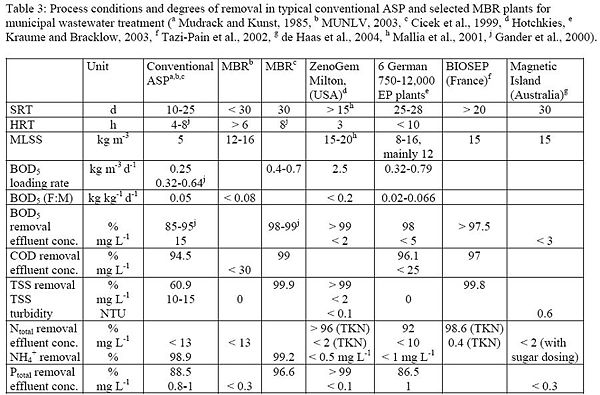
The removal of pollutants is greatly influenced by the length of time fluid elements spend in the MBR (i.e. the residence time distribution
or RTD). The residence time distribution
is a description of the hydrodynamics/mixing in the system and is determined by the design of the MBR (e.g. MBR size, inlet/recycle flowrates, wall/baffle/mixer/aerator positioning, mixing energy input). An example of the effect of mixing is that a continuous stirred-tank reactor will not have as high pollutant conversion per unit volume of reactor as a plug flow
reactor.
The control of fouling, as previously mentioned, is primarily undertaken using coarse bubble aeration. The distribution of bubbles around the membranes, the shear at the membrane surface for cake removal and the size of the bubble are greatly influenced by the mixing/hydrodynamics of the system. The mixing within the system can also influence the production of possible foulants. For example, vessels not completely mixed (i.e. plug flow reactors) are more susceptible to the effects of shock loads which may cause cell lysis and release of soluble microbial products.
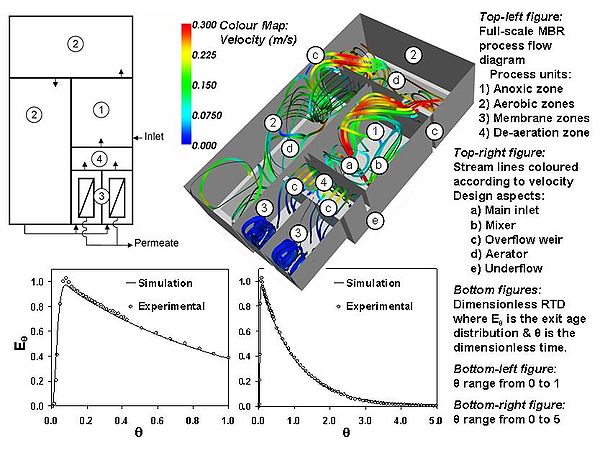 Many factors affect the hydrodynamics of wastewater processes and hence MBRs. These range from physical properties (e.g. mixture rheology
Many factors affect the hydrodynamics of wastewater processes and hence MBRs. These range from physical properties (e.g. mixture rheology
and gas/liquid/solid density etc.) to the fluid boundary conditions (e.g. inlet/outlet/recycle flowrates, baffle/mixer position etc.). However, many factors are peculiar to MBRs, these cover the filtration tank design (e.g. membrane type, multiple outlets attributed to membranes, membrane packing density, membrane orientation etc.) and it’s operation (e.g. membrane relaxation, membrane back flush etc.).
The mixing modelling and design techniques applied to MBRs are very similar to those used for conventional activated sludge
systems. They include the relatively quick and easy compartmental modelling technique which will only derive the RTD of a process (e.g. the MBR) or the process unit (e.g. membrane filtration vessel) and relies on broad assumptions of the mixing properties of each sub unit. Computational fluid dynamics
modelling (CFD) on the other hand does not rely on broad assumptions of the mixing characteristics and attempts to predict the hydrodynamics from a fundamental level. It is applicable to all scales of fluid flow and can reveal much information about the mixing in a process, ranging from the RTD to the shear profile on a membrane surface. Visualisation of MBR CFD modelling results is shown below.
Investigations of MBR hydrodynamics have occurred at many different scales, ranging from examination of shear stress at the membrane surface to RTD analysis of the whole MBR. Cui et al. (2003) investigated the movement of Taylor bubbles through tubular membranes, Khosravi, M. (2007) examined the entire membrane filtration vessel using CFD and velocity measurements, while Brannock et al. (2007) examined the entire MBR using tracer study experiments and RTD analysis.
Membrane technology
The membrane technology covers all process engineering measures for the transport of substances between two fractions with the help of permeable membranes...
like microfiltration
Microfiltration
Microfiltration is a membrane technical filtration process which removes contaminants from a fluid by passage through a microporous membrane. A typical microfiltration membrane pore size range is 0.1 to 10 micrometres...
or ultrafiltration
Ultrafiltration
Ultrafiltration is a variety of membrane filtration in which hydrostatic pressure forces a liquid against a semipermeable membrane. Suspended solids and solutes of high molecular weight are retained, while water and low molecular weight solutes pass through the membrane...
with a suspended growth bioreactor
Bioreactor
A bioreactor may refer to any manufactured or engineered device or system that supports a biologically active environment. In one case, a bioreactor is a vessel in which a chemical process is carried out which involves organisms or biochemically active substances derived from such organisms. This...
, and is now widely used for municipal and industrial wastewater
Wastewater
Wastewater is any water that has been adversely affected in quality by anthropogenic influence. It comprises liquid waste discharged by domestic residences, commercial properties, industry, and/or agriculture and can encompass a wide range of potential contaminants and concentrations...
treatment with plant sizes up to 80,000 population equivalent (i.e. 48 MLD).
Overview

It is possible to operate MBR processes at higher mixed liquor suspended solids (MLSS) concentrations compared to conventional settlement separation systems, thus reducing the reactor volume to achieve the same loading rate.
Two MBR configurations exist: internal/submerged, where the membranes are immersed in and integral to the biological reactor; and external/sidestream, where membranes are a separate unit process requiring an intermediate pumping step.


MBR history and basic operating parameters
The MBR process was introduced by the late 1960s, as soon as commercial scale ultrafiltrationUltrafiltration
Ultrafiltration is a variety of membrane filtration in which hydrostatic pressure forces a liquid against a semipermeable membrane. Suspended solids and solutes of high molecular weight are retained, while water and low molecular weight solutes pass through the membrane...
(UF) and microfiltration
Microfiltration
Microfiltration is a membrane technical filtration process which removes contaminants from a fluid by passage through a microporous membrane. A typical microfiltration membrane pore size range is 0.1 to 10 micrometres...
(MF) membranes were available. The original process was introduced by Dorr-Olivier Inc. and combined the use of an activated sludge
Activated sludge
Activated sludge is a process for treating sewage and industrial wastewaters using air and a biological floc composed of bacteria and protozoans.-Purpose:...
bioreactor with a crossflow membrane filtration loop. The flat sheet membranes used in this process were polymeric and featured pore sizes ranging from 0.003 to 0.01 μm. Although the idea of replacing the settling tank of the conventional activated sludge
Activated sludge
Activated sludge is a process for treating sewage and industrial wastewaters using air and a biological floc composed of bacteria and protozoans.-Purpose:...
process was attractive, it was difficult to justify the use of such a process because of the high cost of membranes, low economic value of the product (tertiary effluent) and the potential rapid loss of performance due to membrane fouling. As a result, the focus was on the attainment of high fluxes, and it was therefore necessary to pump the mixed liquor suspended solids (MLSS) at high crossflow velocity at significant energy penalty (of the order 10 kWh/m3 product) to reduce fouling. Due to the poor economics of the first generation MBRs, they only found applications in niche areas with special needs like isolated trailer parks or ski resorts for example.
The breakthrough for the MBR came in 1989 with the idea of Yamamoto and co-workers to submerge the membranes in the bioreactor. Until then, MBRs were designed with the separation device located external to the reactor (sidestream MBR) and relied on high transmembrane pressure (TMP) to maintain filtration. With the membrane directly immersed into the bioreactor, submerged MBR systems are usually preferred to sidestream configuration, especially for domestic wastewater treatment. The submerged configuration relies on coarse bubble aeration to produce mixing and limit fouling. The energy demand of the submerged system can be up to 2 orders of magnitude lower than that of the sidestream systems and submerged systems operate at a lower flux, demanding more membrane area. In submerged configurations, aeration is considered as one of the major parameter on process performances both hydraulic and biological. Aeration maintains solids in suspension, scours the membrane surface and provides oxygen to the biomass, leading to a better biodegradability and cell synthesis.
The other key steps in the recent MBR development were the acceptance of modest fluxes (25% or less of those in the first generation), and the idea to use two-phase bubbly flow to control fouling. The lower operating cost obtained with the submerged configuration along with the steady decrease in the membrane cost encouraged an exponential increase in MBR plant installations from the mid 90s. Since then, further improvements in the MBR design and operation have been introduced and incorporated into larger plants. While early MBRs were operated at solid retention times (SRT) as high as 100 days with mixed liquor suspended solids up to 30 g/L, the recent trend is to apply lower solid retention times (around 10–20 days), resulting in more manageable mixed liquor suspended solids (MLSS) levels (10-15 g/L). Thanks to these new operating conditions, the oxygen transfer and the pumping cost in the MBR have tended to decrease and overall maintenance has been simplified. There is now a range of MBR systems commercially available, most of which use submerged membranes although some external modules are available; these external systems also use two-phase flow for fouling control. Typical hydraulic retention times (HRT) range between 3 and 10 hours. In terms of membrane configurations, mainly hollow fibre and flat sheet membranes are applied for MBR applications.
Despite the more favourable energy usage of submerged membranes, there continued to be a market for the side stream configuration, particularly in industrial applications. For ease of maintenance the side stream configuration can be installed at low level in a plant building. Membrane replacement can be undertaken without specialised lifting equipment. As a result research continued with the side stream configuration, during which time it was found that full scale plants could be operated with higher fluxes. This has culminated in recent years with the development of low energy systems which incorporate more sophisticated control of the operating parameters coupled with periodic back washes, which enable sustainable operation at energy usage as low as 0.3 kWh/m3 product.
Internal/submerged
The filtration element is installed in either the main bioreactor vessel or in a separate tank. The membranes can be flat sheet or tubular or combination of both, and can incorporate an online backwash system which reduces membrane surface fouling by pumping membrane permeate back through the membrane. In systems where the membranes are in a separate tank to the bioreactor individual trains of membranes can be isolated to undertake cleaning regimes incorporating membrane soaks, however the biomass must be continuously pumped back to the main reactor to limit MLSS concentration increase. Additional aeration is also required to provide air scour to reduce fouling. Where the membranes are installed in the main reactor, membrane modules are removed from the vessel and transferred to an offline cleaning tank.External/sidestream
The filtration elements are installed externally to the reactor, often in a plant room. The biomass is either pumped directly through a number of membrane modules in series and back to the bioreactor, or the biomass is pumped to a bank of modules, from which a second pump circulates the biomass through the modules in series. Cleaning and soaking of the membranes can be undertaken in place with use of an installed cleaning tank, pump and pipework.Fouling and fouling control
The MBR filtration performance inevitably decreases with filtration time. This is due to the deposition of soluble and particulate materials onto and into the membrane, attributed to the interactions between activated sludgeActivated sludge
Activated sludge is a process for treating sewage and industrial wastewaters using air and a biological floc composed of bacteria and protozoans.-Purpose:...
components and the membrane. This major drawback and process limitation has been under investigation since the early MBRs, and remains one of the most challenging issues facing further MBR development,.

Membrane fouling results from interaction between the membrane material and the components of the activated sludge liquor, which include biological flocs formed by a large range of living or dead microorganisms along with soluble and colloidal compounds. The suspended biomass has no fixed composition and varies both with feed water composition and MBR operating conditions employed. Thus though many investigations of membrane fouling have been published, the diverse range of operating conditions and feedwater matrices employed, the different analytical methods used and the limited information reported in most studies on the suspended biomass composition, has made it difficult to establish any generic behaviour pertaining to membrane fouling in MBRs specifically.

Many other anti-fouling strategies can be applied to MBR applications. They comprise, for example:
- Intermittent permeation, where the filtration is stopped at regular time interval for a couple of minutes before being resumed. Particles deposited on the membrane surface tend to diffuse back to the reactor; this phenomenon being increased by the continuous aeration applied during this resting period.
- Membrane backwashing, where permeate water is pumped back to the membrane, and flow through the pores to the feed channel, dislodging internal and external foulants.
- Air backwashing, where pressurized air in the permeate side of the membrane build up and release a significant pressure within a very short period of time. Membrane modules therefore need to be in a pressurised vessel coupled to a vent system. Air usually does not go through the membrane. If it did, the air would dry the membrane and a rewet step would be necessary, by pressurizing the feed side of the membrane.
- Proprietary anti-fouling products, such as Nalco's Membrane Performance Enhancer Technology http://www.nalco.com/ASP/applications/membrane_tech/products/mpe.asp.
In addition, different types/intensities of chemical cleaning may also be recommended:
- Chemically enhanced backwash (daily);
- Maintenance cleaning with higher chemical concentration (weekly);
- Intensive chemical cleaning (once or twice a year).
Intensive cleaning is also carried out when further filtration cannot be sustained because of an elevated transmembrane pressure (TMP). Each of the four main MBR suppliers (Kubota, Memcor, Mitsubishi and Zenon) have their own chemical cleaning recipes, which differ mainly in terms of concentration and methods (see Table 1). Under normal conditions, the prevalent cleaning agents remain NaOCl (Sodium Hypochlorite) and citric acid. It is common for MBR suppliers to adapt specific protocols for chemical cleanings (i.e. chemical concentrations and cleaning frequencies) for individual facilities.

COD removal and sludge yield
Simply due to the high number of microorganism in MBRs, the pollutants uptake rate can be increased. This leads to better degradation in a given time span or to smaller required reactor volumes. In comparison to the conventional activated sludgeActivated sludge
Activated sludge is a process for treating sewage and industrial wastewaters using air and a biological floc composed of bacteria and protozoans.-Purpose:...
process (ASP) which typically achieves 95%, COD removal can be increased to 96-99% in MBRs (see table,). COD and BOD5 removal are found to increase with MLSS concentration. Above 15g/L COD removal becomes almost independent of biomass concentration at >96%. Arbitrary high MLSS concentrations are not employed, however, as oxygen transfer is impeded due to higher and Non-Newtonian fluid
Non-Newtonian fluid
A non-Newtonian fluid is a fluid whose flow properties differ in any way from those of Newtonian fluids. Most commonly the viscosity of non-Newtonian fluids is not independent of shear rate or shear rate history...
viscosity. Kinetics may also differ due to easier substrate access. In ASP, flocs may reach several 100 μm in size. This means that the substrate can reach the active sites only by diffusion which causes an additional resistance and limits the overall reaction rate (diffusion controlled). Hydrodynamic stress in MBRs reduces floc size (to 3.5 μm in sidestream MBRs) and thereby increases the apparent reaction rate. Like in the conventional ASP, sludge yield is decreased at higher SRT or biomass concentration. Little or no sludge is produced at sludge loading rates of 0.01 kgCOD/(kgMLSS d). Due to the biomass concentration limit imposed, such low loading rates would result in enormous tank sizes or long HRTs in conventional ASP.
Nutrient removal
Nutrient removal is one of the main concerns in modern wastewater treatmentWastewater Treatment
Wastewater treatment may refer to:* Sewage treatment* Industrial wastewater treatment...
especially in areas that are sensitive to eutrophication
Eutrophication
Eutrophication or more precisely hypertrophication, is the movement of a body of water′s trophic status in the direction of increasing plant biomass, by the addition of artificial or natural substances, such as nitrates and phosphates, through fertilizers or sewage, to an aquatic system...
. Like in the conventional ASP, currently, the most widely applied technology for N-removal from municipal wastewater is nitrification
Nitrification
Nitrification is the biological oxidation of ammonia with oxygen into nitrite followed by the oxidation of these nitrites into nitrates. Degradation of ammonia to nitrite is usually the rate limiting step of nitrification. Nitrification is an important step in the nitrogen cycle in soil...
combined with denitrification
Denitrification
Denitrification is a microbially facilitated process of nitrate reduction that may ultimately produce molecular nitrogen through a series of intermediate gaseous nitrogen oxide products....
. Besides phosphorus precipitation, enhanced biological phosphorus removal
Enhanced biological phosphorus removal
Enhanced biological phosphorus removal is a wastewater treatment configuration applied to activated sludge systems for the removal of phosphate....
(EBPR) can be implemented which requires an additional anaerobic process step. Some characteristics of MBR technology render EBPR in combination with post-denitrification an attractive alternative that achieves very low nutrient effluent concentrations.

Anaerobic MBRs
Anaerobic MBRs were introduced in the 1980s in South Africa and currently see a renaissance in research. However, anaerobic processes are normally used when a low cost treatment is required that enables energy recovery but does not achieve advanced treatment (low carbon removal, no nutrients removal). In contrast, membrane-based technologies enable advanced treatment (disinfection), but at high energy cost. Therefore, the combination of both can only be economically viable if a compact process for energy recovery is desired, or when disinfection is required after anaerobic treatment (cases of water reuse with nutrients). If maximal energy recovery is desired, a single anaerobic process will be always superior to a combination with a membrane process.Mixing/Hydrodynamics
Like in any other reactors, the hydrodynamics (or mixing) within an MBR plays an important role in determining the pollutant removal and fouling control within an MBR. It has a substantial effect on the energy usage and size requirements of an MBR, therefore the whole life cost of an MBR is high.The removal of pollutants is greatly influenced by the length of time fluid elements spend in the MBR (i.e. the residence time distribution
Residence Time Distribution
The residence time distribution of a chemical reactor is a probability distribution function that describes the amount of time a fluid element could spend inside the reactor. Chemical engineers use the RTD to characterize the mixing and flow within reactors and to compare the behavior of real...
or RTD). The residence time distribution
Residence Time Distribution
The residence time distribution of a chemical reactor is a probability distribution function that describes the amount of time a fluid element could spend inside the reactor. Chemical engineers use the RTD to characterize the mixing and flow within reactors and to compare the behavior of real...
is a description of the hydrodynamics/mixing in the system and is determined by the design of the MBR (e.g. MBR size, inlet/recycle flowrates, wall/baffle/mixer/aerator positioning, mixing energy input). An example of the effect of mixing is that a continuous stirred-tank reactor will not have as high pollutant conversion per unit volume of reactor as a plug flow
Plug flow
In fluid mechanics, plug flow is a simple model of the velocity profile of a fluid flowing in a pipe. In plug flow, the velocity of the fluid is assumed to be constant across any cross-section of the pipe perpendicular to the axis of the pipe...
reactor.
The control of fouling, as previously mentioned, is primarily undertaken using coarse bubble aeration. The distribution of bubbles around the membranes, the shear at the membrane surface for cake removal and the size of the bubble are greatly influenced by the mixing/hydrodynamics of the system. The mixing within the system can also influence the production of possible foulants. For example, vessels not completely mixed (i.e. plug flow reactors) are more susceptible to the effects of shock loads which may cause cell lysis and release of soluble microbial products.

Rheology
Rheology is the study of the flow of matter, primarily in the liquid state, but also as 'soft solids' or solids under conditions in which they respond with plastic flow rather than deforming elastically in response to an applied force....
and gas/liquid/solid density etc.) to the fluid boundary conditions (e.g. inlet/outlet/recycle flowrates, baffle/mixer position etc.). However, many factors are peculiar to MBRs, these cover the filtration tank design (e.g. membrane type, multiple outlets attributed to membranes, membrane packing density, membrane orientation etc.) and it’s operation (e.g. membrane relaxation, membrane back flush etc.).
The mixing modelling and design techniques applied to MBRs are very similar to those used for conventional activated sludge
Activated sludge
Activated sludge is a process for treating sewage and industrial wastewaters using air and a biological floc composed of bacteria and protozoans.-Purpose:...
systems. They include the relatively quick and easy compartmental modelling technique which will only derive the RTD of a process (e.g. the MBR) or the process unit (e.g. membrane filtration vessel) and relies on broad assumptions of the mixing properties of each sub unit. Computational fluid dynamics
Computational fluid dynamics
Computational fluid dynamics, usually abbreviated as CFD, is a branch of fluid mechanics that uses numerical methods and algorithms to solve and analyze problems that involve fluid flows. Computers are used to perform the calculations required to simulate the interaction of liquids and gases with...
modelling (CFD) on the other hand does not rely on broad assumptions of the mixing characteristics and attempts to predict the hydrodynamics from a fundamental level. It is applicable to all scales of fluid flow and can reveal much information about the mixing in a process, ranging from the RTD to the shear profile on a membrane surface. Visualisation of MBR CFD modelling results is shown below.
Investigations of MBR hydrodynamics have occurred at many different scales, ranging from examination of shear stress at the membrane surface to RTD analysis of the whole MBR. Cui et al. (2003) investigated the movement of Taylor bubbles through tubular membranes, Khosravi, M. (2007) examined the entire membrane filtration vessel using CFD and velocity measurements, while Brannock et al. (2007) examined the entire MBR using tracer study experiments and RTD analysis.

